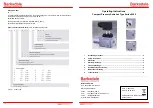
206
LACP is automatically enabled on interfaces in a dynamic aggregation group. For information about
dynamic aggregation groups, see “
Dynamic aggregation mode
”. An LACP-enabled interface sends
LACPDUs to notify the remote system (the partner) of its system LACP priority, system MAC address, LACP
port priority, port number, and operational key. Upon receiving an LACPDU, the partner compares the
received information with the information received on other interfaces to determine the interfaces that can
operate as selected interfaces. This allows the two systems to reach an agreement on which link
aggregation member ports should be placed in Selected state.
Operational key
When aggregating ports, link aggregation control automatically assigns each port an operational key
based on port attributes, including the port rate, duplex mode and link state configuration.
In an aggregation group, all selected ports are assigned the same operational key.
Class-two configurations
The contents of class-two configurations are listed in
1
. A member port can be placed in the Selected state
only if it has the same class-two configurations as the aggregate interface.
1.
Class-two configurations
Type
Considerations
Port isolation
Whether a port has joined an isolation group.
VLAN
Permitted VLAN IDs, PVID, link type (trunk, hybrid, or access), and tag mode.
MAC address learning
MAC address learning limit.
NOTE:
Some configurations are called class-one configurations. Such configurations, for example, MSTP, can
be configured on aggregate interfaces and member ports but are not considered during operational
key calculation. For more information about MSTP configuration on member ports of link aggregation
groups or aggregate interfaces, see the chapter “MSTP configuration”.
Any class-two configuration change may affect the aggregation state of link aggregation member
ports and ongoing traffic. To make sure that you are aware of the risk, the system displays a warning
message every time you attempt to change a class-two configuration setting on a member port. For
more information about the port isolation configuration, VLAN configuration, and MAC address
learning limit configuration on member ports of link aggregation groups or aggregate interfaces, see
the chapters “Port isolation configuration”, “VLAN configuration”, and “Port management
configuration”.
Link aggregation modes
Link aggregation has the following modes: dynamic and static.
Static aggregation mode
LACP is disabled on the member ports in a static aggregation group. In a static aggregation group, the
system sets a port to Selected or Unselected state by the following rules:
Select a port as the reference port from the ports that are in up state and have the same class-two
configurations as the corresponding aggregate interface. The candidate ports are sorted by
Содержание V1910
Страница 1: ...1 HP V1910 Switch Series User Guide 5998 2238 Part number 5998 2238 Document version 2 ...
Страница 85: ...73 c Display the rate settings of ports ...
Страница 102: ...90 a Port traffic statistics ...
Страница 186: ...174 a The MAC tab Click Add in the bottom to enter the page as shown in b b Create a MAC address entry ...
Страница 252: ...240 b The Port Setup tab ...
Страница 260: ...248 d The Port Setup tab ...
Страница 362: ...350 a Ping operation summary ...
Страница 421: ...409 c Configure authorized IP ...
Страница 479: ...467 Index A B C D E F G H I L M O P Q R S T V W ...
















































